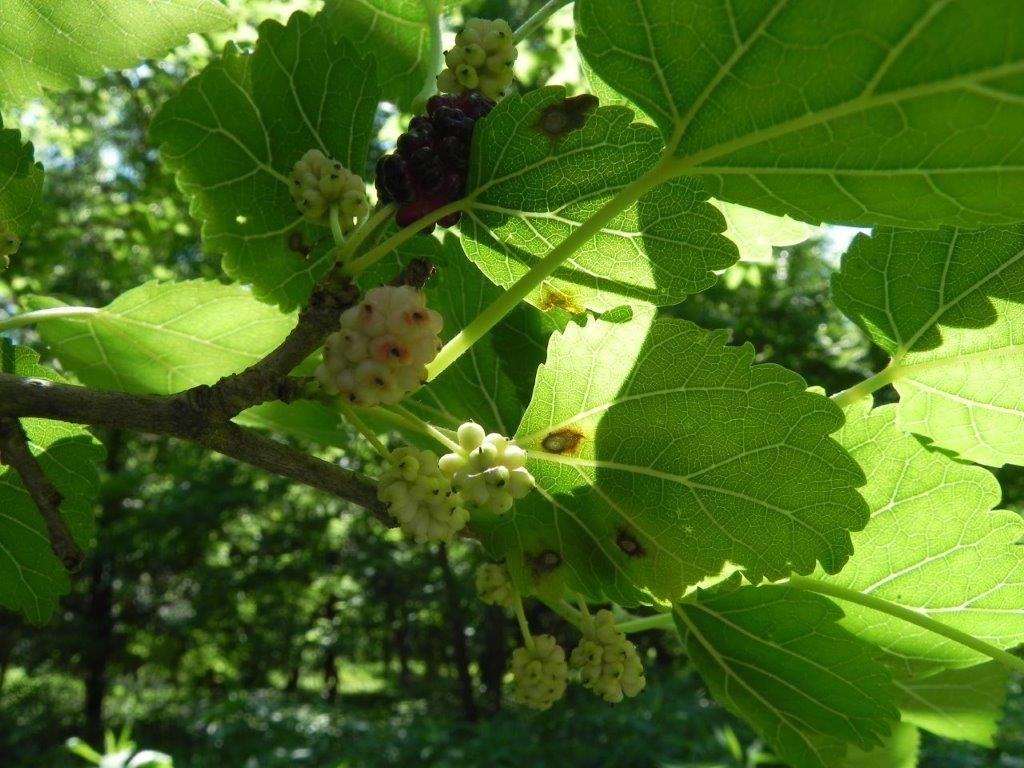Mimosa
Genus/species: Albizia julibrissin
Description: Mimosa is a small deciduous tree that grows 20 to 40 feet tall. The light brown bark is thin and smooth with lens-shaped spots along the stem. Identifying characteristics include compound alternate fern-like leaves that are finely divided, 5 to 8 inches long by 3 to 4 inches wide. The pink fragrant flowers look like pom-poms at the ends of branches and are produced in early summer. The fruit are flat, 6 inch long seedpods that develop in the late summer. The tree grows vigorously and displaces native trees and shrubs. Once established it is difficult to remove due to its long-lived seeds and ability to resprout vigorously. For control cutting is done prior to seed set, with follow-up cuttings in combination with herbicide treatments due to re-sprouts.
Osage Orange
Genus/species: Maclura promifera
Description: Osage Orange is a fruit bearing, medium sized tree that can grow up to 40 feet tall. The tree has a short trunk with upper branches arching upwards and lower branches drooping downward which creates dense shade. The bark is light gray-brown tinged with orange. Identifying characteristics include shiny, deciduous, simple, alternating leaves that are ovate with a long pointed tip. The staminate (male) flower are green, hairy and in cylindrical clusters. The staminate flowers are green and in dense globular clusters. The fruit is produced in September by the female tree. The green-yellow fruit (hedge apple) can be up to 6 inches in diameter and contains many seeds. In late September to early November, workers should wear hardhats for protection against the falling fruit. For control, an appropriate herbicide is effective as bark treatment, cut-surface stump, or girdle treatment.
Royale Paulownia
Genus/species:Paulownia tomentosa
Description: The Royal Paulownia is a medium size tree that can reach 30 to 60 feet tall. The bark is rough, gray-brown, and interlaced with shiny smooth areas. Identifying characteristics include opposite, deciduous, large (6 to 16 inches) pale light green leaves which are broadly oval to heart-shape or shallowly three-lobed. The leaves are pale green and hairy underneath. Large, showy, fragrant flowers blossom at the ends of stout, hairy, twigs from April to May. Blooming occurs before the leaves emerge from the round, hairy buds formed the previous summer. The seedpod has four compartments and can release up to 2,000 tiny winged seeds in autumn. After the release the seedpods remained attached through the winter. This tree grows rapidly, often on steep rocky slopes that may be habitats for rare native plants. For control, an appropriate herbicide is effective as bark treatment, cut-surface stump, or girdle treatment.
Tree of Heaven
Genus/species: Ailanthus altissima
Description: Tree of Heaven is a tree that can grow quickly and can reach a maximum height of 90 feet. Identifying characteristics include a bark that is relatively smooth and gray to brownish grey. The large compound leaves are 1’ to 4’ feet long with 11 to 25 smaller leaflets attached opposite each other. Flowers are clusters of small, yellow-green flowers near the end of the leaf branch. Seeds are produced on female trees in late summer to early fall. All parts of the tree have an offensive odor often compared to rancid peanut butter. Care must be taken to remove the entire smaller plant. Large trees must be cut by professionals and the stump treated to prevent suckering which will produce an abundance of seedlings.
White Mulberry
Genus/species: Malus alba
Description: White Mulberry is a deciduous tree that grows up to 40 feet tall. The tree’s younger bark is bright orange and the older bark is gray. This tree invades forest edges, disturbed forests, and open areas, displacing native species. It is replacing our native red mulberry through hybridization and theoretically through transmission of a harmful root disease. Identifying characteristics include simple, glossy lance-like, alternate leaves that are flat and broad, lobed or not lobed. Male and female flowers are on separate plants. The small green male flowers occur in 1 to 2 inch elongated clusters (catkins); female flowers are crowded in short spikes. The cylindrical, 1” to 1½” fruit form from the female flowers and resemble blackberries. During ripening these change color from white to pink to black in late summer. A single tree can produce an estimated twenty million seeds! Seedlings can be pulled by hand. Large trees must be removed by cutting the tree and using an appropriate herbicide to treat the cut stump or girdling the trunk and painting the cut surface with an herbicide.























